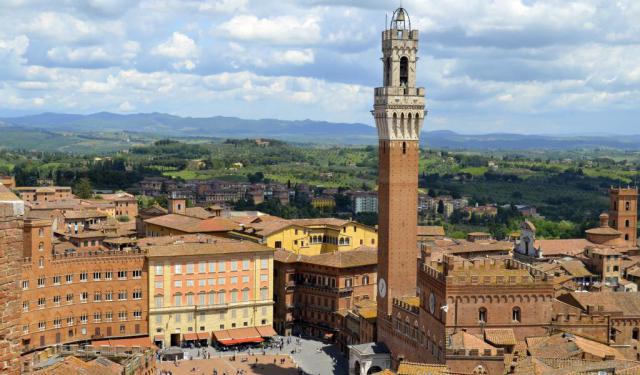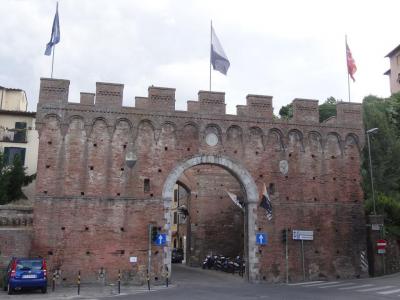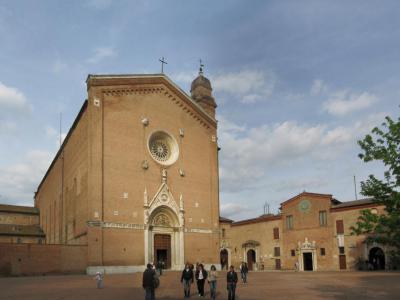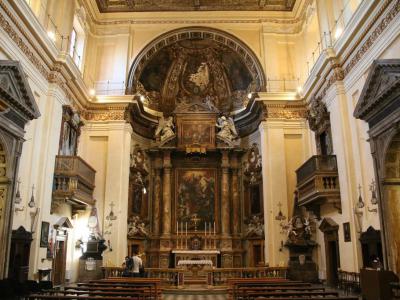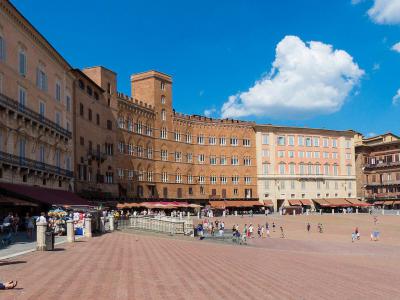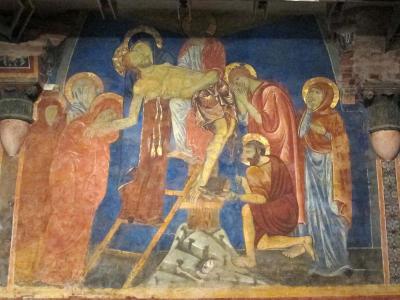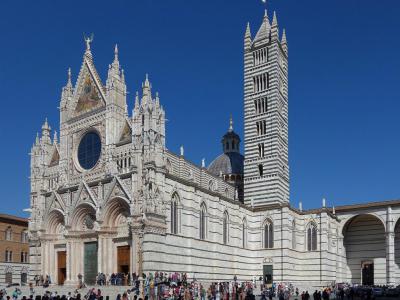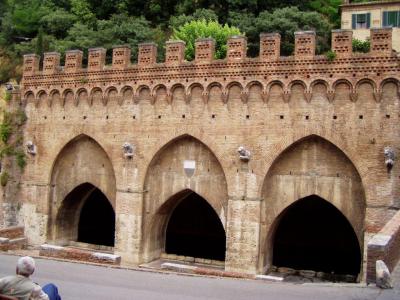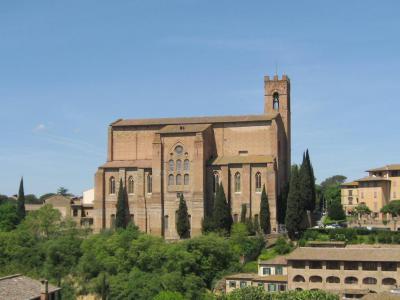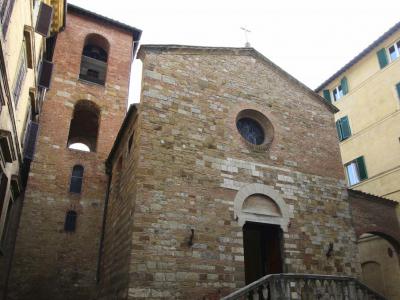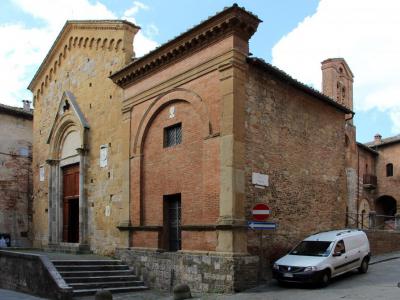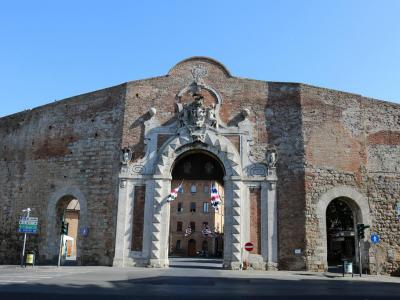Medieval Siena Walking Tour (Self Guided), Siena
Siena is a beautiful medieval city whose Gothic-era identity, acquired between the 12th and 15th centuries, has been successfully preserved due to the centuries of political and economic irrelevance in the shadow of its grander neighbor Florence. Today's Siena is a cultural gold mine and ideal place to revel in medieval Italy.
No tour of Siena is complete without visiting its heart, the gorgeous Piazza Del Campo – one of Europe’s finest and most important medieval squares – around which the entire city was built.
If Piazza Del Campo is the heart of Siena, then the Duomo (Siena Cathedral) is its soul. Built atop the city's highest point in 1263, on the site of a 9th-century church, this white and dark-green striped temple is lavished with statues and mosaics.
As for Cripta del Duomo di Siena (Crypt of the Siena Cathedral) – this is an attraction in its own right in terms of medieval archaeology; rediscovered in 1999.
Basilica of San Francesco – a Romanesque-style church built in the 13th century and expanded two centuries later with a Gothic facade.
Chiesa di San Vigilio (San Vigilio Church) – originally built in the 11th century, restored after a fire in 1231; dedicated to Bishop and martyr St Vigillius.
St Catherine Sanctuary – honors one of Siena's most revered citizens, known as "the mystic of politics" who fought corruption in the Catholic Church.
Fonte Branda (Branda Fountain) – the oldest city fountain in Siena and a principal source of water in the city during the middle ages; built in 1246.
To find yourself in an architectural time warp and explore these and other medieval attractions of Siena in more detail, take this self-guided walking tour.
No tour of Siena is complete without visiting its heart, the gorgeous Piazza Del Campo – one of Europe’s finest and most important medieval squares – around which the entire city was built.
If Piazza Del Campo is the heart of Siena, then the Duomo (Siena Cathedral) is its soul. Built atop the city's highest point in 1263, on the site of a 9th-century church, this white and dark-green striped temple is lavished with statues and mosaics.
As for Cripta del Duomo di Siena (Crypt of the Siena Cathedral) – this is an attraction in its own right in terms of medieval archaeology; rediscovered in 1999.
Basilica of San Francesco – a Romanesque-style church built in the 13th century and expanded two centuries later with a Gothic facade.
Chiesa di San Vigilio (San Vigilio Church) – originally built in the 11th century, restored after a fire in 1231; dedicated to Bishop and martyr St Vigillius.
St Catherine Sanctuary – honors one of Siena's most revered citizens, known as "the mystic of politics" who fought corruption in the Catholic Church.
Fonte Branda (Branda Fountain) – the oldest city fountain in Siena and a principal source of water in the city during the middle ages; built in 1246.
To find yourself in an architectural time warp and explore these and other medieval attractions of Siena in more detail, take this self-guided walking tour.
How it works: Download the app "GPSmyCity: Walks in 1K+ Cities" from Apple App Store or Google Play Store to your mobile phone or tablet. The app turns your mobile device into a personal tour guide and its built-in GPS navigation functions guide you from one tour stop to next. The app works offline, so no data plan is needed when traveling abroad.
Medieval Siena Walking Tour Map
Guide Name: Medieval Siena Walking Tour
Guide Location: Italy » Siena (See other walking tours in Siena)
Guide Type: Self-guided Walking Tour (Sightseeing)
# of Attractions: 12
Tour Duration: 2 Hour(s)
Travel Distance: 3.5 Km or 2.2 Miles
Author: irenebo
Sight(s) Featured in This Guide:
Guide Location: Italy » Siena (See other walking tours in Siena)
Guide Type: Self-guided Walking Tour (Sightseeing)
# of Attractions: 12
Tour Duration: 2 Hour(s)
Travel Distance: 3.5 Km or 2.2 Miles
Author: irenebo
Sight(s) Featured in This Guide:
- Porta Ovile (Ovile Gate)
- Basilica of San Francesco
- Chiesa di San Vigilio (San Vigilio Church)
- Piazza del Campo (Campo Square)
- Cripta del Duomo di Siena (Crypt of Siena Cathedral)
- Duomo di Siena (Siena Cathedral)
- St. Catherine Sanctuary
- Fonte Branda (Branda Fountain)
- Basilica of San Domenico
- Chiesa di Sant'Andrea (St. Andrew Church)
- Chiesa di San Pietro alla Magione (Saint Peter of the Mansion Church)
- Porta Camollia (Camollia Gate)
1) Porta Ovile (Ovile Gate)
Ovile Gate (Porta Ovile) is a historic city gate located in Siena, notable for its age, architectural features, and cultural significance within the city's medieval walls. Dating back to its first mention in 1220, this gate is strategically positioned between Vallerozzi and Simone Martini Streets (Via di Vallerozzi and Via Simone Martini). Its construction was initially completed around 1230, making it one of the oldest parts of the Sienese fortifications.
Significant for its robust and enduring design, Ovile Gate was involved in the defensive and urban developments of Siena through the Middle Ages. In 1251, it was fortified as a precaution against potential attacks from Florence, reflecting its importance in the city's defense strategy. Historical records from the Biccherna of 1250 refer to it as the "Gate of the Flock" (Porta del Gregge), indicating its role in local commerce and community life.
One of the most striking features of the Ovile Gate depicts the Madonna and Child, alongside Saints Ansano, Bernardino, and Angels. This fresco, dating from the 14th century, is not only a religious symbol but also represents one of the oldest remaining frescoes on Siena’s ancient walls.
Over the centuries, the Ovile Gate has witnessed several significant events. It was temporarily sealed in 1554 during the siege of Siena and used tactically to enhance the city's defenses against external threats. Unfortunately, it suffered considerable damage during an earthquake in 1798 that impacted the entire Ovile district.
Today, the Ovile Gate stands as a testament to Siena's rich history and cultural heritage. It remains well-preserved and is easily accessible from the city center, close to many of Siena’s main attractions. Its historical significance and architectural beauty continue to draw both locals and tourists, making it a cherished landmark within the vibrant tapestry of Siena’s past and present.
Significant for its robust and enduring design, Ovile Gate was involved in the defensive and urban developments of Siena through the Middle Ages. In 1251, it was fortified as a precaution against potential attacks from Florence, reflecting its importance in the city's defense strategy. Historical records from the Biccherna of 1250 refer to it as the "Gate of the Flock" (Porta del Gregge), indicating its role in local commerce and community life.
One of the most striking features of the Ovile Gate depicts the Madonna and Child, alongside Saints Ansano, Bernardino, and Angels. This fresco, dating from the 14th century, is not only a religious symbol but also represents one of the oldest remaining frescoes on Siena’s ancient walls.
Over the centuries, the Ovile Gate has witnessed several significant events. It was temporarily sealed in 1554 during the siege of Siena and used tactically to enhance the city's defenses against external threats. Unfortunately, it suffered considerable damage during an earthquake in 1798 that impacted the entire Ovile district.
Today, the Ovile Gate stands as a testament to Siena's rich history and cultural heritage. It remains well-preserved and is easily accessible from the city center, close to many of Siena’s main attractions. Its historical significance and architectural beauty continue to draw both locals and tourists, making it a cherished landmark within the vibrant tapestry of Siena’s past and present.
2) Basilica of San Francesco
The Basilica of San Francesco in Siena is a significant religious and architectural landmark. Originally erected around 1228-1255, this church was initially designed in the Romanesque style but was substantially enlarged and transformed into a Gothic structure during the 14th and 15th centuries. This transition reflects the needs of the Mendicant Orders for which the church was built, requiring ample space to accommodate large congregations. The basilica follows an Egyptian Cross plan with a broad nave and transept.
Despite its historical and artistic significance, the interior of the Basilica of San Francesco appears relatively sober today. This is largely due to a fire in 1655 and a substantial restoration between 1885 and 1892, which led to the removal of many Baroque altars. However, efforts have been made to return some of the artworks that were once removed.
The façade of the basilica is neo-Gothic, a result of early 20th-century renovations, and is flanked by a campanile dating back to 1763. Previous medieval decorations and a 15th-century portal were removed during these updates.
Inside, the counterfaçade holds significant historical pieces including two 14th-century sepulchers and large frescoes originally from Siena's city gates-Porta Romana and Porta Pispini. These include the "Coronation of the Virgin" by Sassetta and Sano di Pietro (1447-1450) and a "Nativity" by Il Sodoma (1531).
The basilica also houses an impressive collection of artworks by notable Italian artists. Among these are the "Madonna with Child and Saints" by Jacopo Zucchi, "Crucifixion" by Pietro Lorenzetti, and a fresco by his brother Ambrogio. Other remarkable works include the "Prayer of Saint James" by Giuseppe Nicola Nasini, "Martyrdom of Saint Martina" by Pietro da Cortona, and a "Madonna with Child" fresco by Jacopo di Mino del Pellicciaio.
A notable sculpture in the right transept is a 14th-century marble depiction of Saint Francis, salvaged from the church's ancient façade. This piece not only contributes to the historical depth of the basilica but also ties the building’s past architectural elements with its present form.
Despite its historical and artistic significance, the interior of the Basilica of San Francesco appears relatively sober today. This is largely due to a fire in 1655 and a substantial restoration between 1885 and 1892, which led to the removal of many Baroque altars. However, efforts have been made to return some of the artworks that were once removed.
The façade of the basilica is neo-Gothic, a result of early 20th-century renovations, and is flanked by a campanile dating back to 1763. Previous medieval decorations and a 15th-century portal were removed during these updates.
Inside, the counterfaçade holds significant historical pieces including two 14th-century sepulchers and large frescoes originally from Siena's city gates-Porta Romana and Porta Pispini. These include the "Coronation of the Virgin" by Sassetta and Sano di Pietro (1447-1450) and a "Nativity" by Il Sodoma (1531).
The basilica also houses an impressive collection of artworks by notable Italian artists. Among these are the "Madonna with Child and Saints" by Jacopo Zucchi, "Crucifixion" by Pietro Lorenzetti, and a fresco by his brother Ambrogio. Other remarkable works include the "Prayer of Saint James" by Giuseppe Nicola Nasini, "Martyrdom of Saint Martina" by Pietro da Cortona, and a "Madonna with Child" fresco by Jacopo di Mino del Pellicciaio.
A notable sculpture in the right transept is a 14th-century marble depiction of Saint Francis, salvaged from the church's ancient façade. This piece not only contributes to the historical depth of the basilica but also ties the building’s past architectural elements with its present form.
3) Chiesa di San Vigilio (San Vigilio Church)
The San Vigilio Church is dedicated to Bishop and martyr Saint Vigillius. The exterior has a classical facade. The church was originally built in the 11th century and occupied by monks. The original church was destroyed in a fire in 1153 and was rebuilt in 1231.
The monks were expelled in 1420, and in 1556, Jesuits took over the church and continued to remodel it. In 1759, the Vallombrosan order took over the church and rebuilt the facade, which remains today. In 1816, the church was gifted to the University of Siena.
The San Vigilio Church's interior features several chapels and various artworks. Visitors will find 15 canvasses created by artist Raffaello Vanni depicting The Last Judgement. The chapel of Saint Francis Borgia features paintings by Dionisio Montorselli. The chapel of Saint Ann has a canvas painting by Romanelli.
The chapel of the Taja family features bronze statues created by Gianlorenzo Bernini's studio. The chapel of Saint Francis Xavier has artwork by Francesco Vanni and Baldassare Franceschini. Finally, the chapel of Madonna di Loreto features additional canvases by Francesco Vanni.
The monks were expelled in 1420, and in 1556, Jesuits took over the church and continued to remodel it. In 1759, the Vallombrosan order took over the church and rebuilt the facade, which remains today. In 1816, the church was gifted to the University of Siena.
The San Vigilio Church's interior features several chapels and various artworks. Visitors will find 15 canvasses created by artist Raffaello Vanni depicting The Last Judgement. The chapel of Saint Francis Borgia features paintings by Dionisio Montorselli. The chapel of Saint Ann has a canvas painting by Romanelli.
The chapel of the Taja family features bronze statues created by Gianlorenzo Bernini's studio. The chapel of Saint Francis Xavier has artwork by Francesco Vanni and Baldassare Franceschini. Finally, the chapel of Madonna di Loreto features additional canvases by Francesco Vanni.
4) Piazza del Campo (Campo Square) (must see)
The Campo Square on the site where three ancient towns met and where three main roads intersect. The square was designed to be a gathering site where the entire town could meet and celebrate holidays, enjoy games, or attend political events.
The Campo Square features a red brick fishtail design that was laid in 1349. Eight lines of white travertine cut through the red brick, creating nine sections. The nine sections represent the nine ruling governors who maintained peace and prosperity in Siena from 1291-1355.
The sections also represent the folds of the Virgin Mary's cloak. The Virgin Mary was Siena's patron saint and considered Siena's ultimate ruler. The nine sections radiate out from the central water drain in front of the Public Palace.
In 1297, the government created guidelines to ensure buildings had a congruent appearance. Therefore, many gorgeous, harmonious buildings face Campo Square. The most notable building in the square is the medieval Gothic Public Palace which was home to the Government of Nine and now houses the Civic Museum.
The Joyous Fountain was built in 1346, and the intricate marble carvings were added in 1409. Underground tunnels feed the Joyous Fountain.
The Palio di Siena, a popular horse race, is held twice a year. The course runs around the edge of the Campo Square and fans pack the square. The yearly road cycling race Strade Bianche finishes at the square. In addition, the Campo Square hosts various Carnival festivities every February.
Why You Should Visit:
The Campo Square is known as one of the most beautiful medieval squares in Italy. This gorgeously preserved square is the heart and soul of Siena and the perfect place to immerse yourself in Siena's culture and history.
Tips:
Enjoy a glass of wine, gelato, or coffee in one of the many cafes and restaurants. Watch the activity in the square and listen for the tower bells ringing.
The Campo Square features a red brick fishtail design that was laid in 1349. Eight lines of white travertine cut through the red brick, creating nine sections. The nine sections represent the nine ruling governors who maintained peace and prosperity in Siena from 1291-1355.
The sections also represent the folds of the Virgin Mary's cloak. The Virgin Mary was Siena's patron saint and considered Siena's ultimate ruler. The nine sections radiate out from the central water drain in front of the Public Palace.
In 1297, the government created guidelines to ensure buildings had a congruent appearance. Therefore, many gorgeous, harmonious buildings face Campo Square. The most notable building in the square is the medieval Gothic Public Palace which was home to the Government of Nine and now houses the Civic Museum.
The Joyous Fountain was built in 1346, and the intricate marble carvings were added in 1409. Underground tunnels feed the Joyous Fountain.
The Palio di Siena, a popular horse race, is held twice a year. The course runs around the edge of the Campo Square and fans pack the square. The yearly road cycling race Strade Bianche finishes at the square. In addition, the Campo Square hosts various Carnival festivities every February.
Why You Should Visit:
The Campo Square is known as one of the most beautiful medieval squares in Italy. This gorgeously preserved square is the heart and soul of Siena and the perfect place to immerse yourself in Siena's culture and history.
Tips:
Enjoy a glass of wine, gelato, or coffee in one of the many cafes and restaurants. Watch the activity in the square and listen for the tower bells ringing.
5) Cripta del Duomo di Siena (Crypt of Siena Cathedral) (must see)
The Crypt of Siena Cathedral, found beneath the Cathedral of Siena in Italy, is a valuable archaeological and artistic discovery made as recently as 1999. Unlike the original crypt believed to be under the cathedral’s dome, this crypt is a vast space containing remnants dating back to the medieval period, especially from the 12th to the 14th centuries.
Rediscovered during restoration work by the Opera del Duomo, the aim was to uncover the Oratory of Saints Giovannino and Gennaro, located beneath the cathedral's choir. During excavation, a room filled with inert material was found, likely filled in the 14th century due to structural issues halting a cathedral expansion project. This unintentional preservation left the crypt remarkably intact.
Inside, there are thirteenth-century frescoes known for their vibrant colors, preserved due to being sealed shortly after creation. These frescoes depict biblical scenes in two tiers: the upper tier shows Old Testament scenes, while the lower tier features New Testament stories, including scenes of the Passion of Christ. The frescoes offer insight into medieval art and the Sienese school of mural painting. Ongoing studies aim to precisely date and attribute them, which could greatly contribute to medieval art history.
Aside from the frescoes, the crypt contains architectural elements like columns, pillars, and capitals adorned with geometric and vegetal motifs, showcasing pre-Renaissance taste for colorful decoration.
Excavations also revealed the foundations of the cathedral’s oldest apse, shedding light on its construction phases from the 12th to the 14th century, with identifiable features such as stone walls from the 13th century and brick compositions from the 14th century.
Rediscovered during restoration work by the Opera del Duomo, the aim was to uncover the Oratory of Saints Giovannino and Gennaro, located beneath the cathedral's choir. During excavation, a room filled with inert material was found, likely filled in the 14th century due to structural issues halting a cathedral expansion project. This unintentional preservation left the crypt remarkably intact.
Inside, there are thirteenth-century frescoes known for their vibrant colors, preserved due to being sealed shortly after creation. These frescoes depict biblical scenes in two tiers: the upper tier shows Old Testament scenes, while the lower tier features New Testament stories, including scenes of the Passion of Christ. The frescoes offer insight into medieval art and the Sienese school of mural painting. Ongoing studies aim to precisely date and attribute them, which could greatly contribute to medieval art history.
Aside from the frescoes, the crypt contains architectural elements like columns, pillars, and capitals adorned with geometric and vegetal motifs, showcasing pre-Renaissance taste for colorful decoration.
Excavations also revealed the foundations of the cathedral’s oldest apse, shedding light on its construction phases from the 12th to the 14th century, with identifiable features such as stone walls from the 13th century and brick compositions from the 14th century.
6) Duomo di Siena (Siena Cathedral) (must see)
Siena Cathedral is one of Italy's most exquisite Cathedrals. The Cathedral was completed in 1263 on the site of a church dating to the 9th century. This stunning Cathedral has a transept, a dome, and a bell tower and features artwork from Italy's most prominent artists.
The dome has a hexagonal base and supporting columns. Famous sculptor Gian Lorenzo Bernini designed the lantern on top of the dome. The bell tower features six bells; the oldest bell was cast in 1149. The Cathedral was built with white and dark-colored marble in alternating stripes. White and black are the colors of Siena and represent the white and black horses of the city's founders, Senius and Aschius.
Giovanni Pisano, Nicola Pisano's son, created the west facade with carved sculptures of the prophets and philosophers. The original sculptures are now housed in the Cathedral Treasures Museum, while copies are displayed in the facade.
The mosaic inlay floor is the Cathedral's prized possession and has been called the most beautiful floor ever made. Fifty-six inlay panels were drawn by various Sienese artists and transposed into the marble mosaic inlay.
The most celebrated Italian artists created artwork on display in the Cathedral. Donatello created a statue of Saint John the Baptist in the Saint John the Baptist chape. Michelangelo carved four statues, Saint Peter, Saint Paul, Saint Pius, and Saint Augustine, for the Piccolomini altar. Gian Lorenzo Bernini carved the statues of Saint Mary Magdalen and Saint Jerome in the Chapel of the Vow. Nicola Pisano carved the pulpit that can be seen in the north transept.
A copy of Duccio di Boninsegna's stained glass window is on display. The original is in the Cathedral Treasures Museum. Several other notable stained glass works beautify the Cathedral.
The Cathedral Choir features eight wood-carved inlays by Fra Giovanni da Verona. Underneath the choir, a narthex, long filled with rubble, was excavated between 1999 and 2003. The excavation uncovered 13th-century frescoes depicting scenes from the life of Christ.
Why You Should Visit:
The Siena Cathedral is regarded as one of the most beautiful Cathedrals in Italy and shows the pinnacle of Siena's beauty and commitment to artistry. Statues by Donatello, Michelangelo, and Bernini are just some of the artworks on display.
Tips:
Inside the main entrance, there's a sign with a map of the Cathedral's floorplan. Take a photo of this map with your phone, so you don't get lost as you explore the massive Cathedral and take in all the sights.
The Cathedral is open until 7 pm and is less crowded in the early evening. The floor is only uncovered during specific dates; check online to see if the floor is uncovered during your visit.
The dome has a hexagonal base and supporting columns. Famous sculptor Gian Lorenzo Bernini designed the lantern on top of the dome. The bell tower features six bells; the oldest bell was cast in 1149. The Cathedral was built with white and dark-colored marble in alternating stripes. White and black are the colors of Siena and represent the white and black horses of the city's founders, Senius and Aschius.
Giovanni Pisano, Nicola Pisano's son, created the west facade with carved sculptures of the prophets and philosophers. The original sculptures are now housed in the Cathedral Treasures Museum, while copies are displayed in the facade.
The mosaic inlay floor is the Cathedral's prized possession and has been called the most beautiful floor ever made. Fifty-six inlay panels were drawn by various Sienese artists and transposed into the marble mosaic inlay.
The most celebrated Italian artists created artwork on display in the Cathedral. Donatello created a statue of Saint John the Baptist in the Saint John the Baptist chape. Michelangelo carved four statues, Saint Peter, Saint Paul, Saint Pius, and Saint Augustine, for the Piccolomini altar. Gian Lorenzo Bernini carved the statues of Saint Mary Magdalen and Saint Jerome in the Chapel of the Vow. Nicola Pisano carved the pulpit that can be seen in the north transept.
A copy of Duccio di Boninsegna's stained glass window is on display. The original is in the Cathedral Treasures Museum. Several other notable stained glass works beautify the Cathedral.
The Cathedral Choir features eight wood-carved inlays by Fra Giovanni da Verona. Underneath the choir, a narthex, long filled with rubble, was excavated between 1999 and 2003. The excavation uncovered 13th-century frescoes depicting scenes from the life of Christ.
Why You Should Visit:
The Siena Cathedral is regarded as one of the most beautiful Cathedrals in Italy and shows the pinnacle of Siena's beauty and commitment to artistry. Statues by Donatello, Michelangelo, and Bernini are just some of the artworks on display.
Tips:
Inside the main entrance, there's a sign with a map of the Cathedral's floorplan. Take a photo of this map with your phone, so you don't get lost as you explore the massive Cathedral and take in all the sights.
The Cathedral is open until 7 pm and is less crowded in the early evening. The floor is only uncovered during specific dates; check online to see if the floor is uncovered during your visit.
7) St. Catherine Sanctuary
Saint Catherine of Siena is one of Siena's most revered citizens. She is known as "the mystic of politics" and fought corruption in the Catholic Church. She traveled to convince the Pope to move back to Rome from Avignon.
The Saint Catherine Sanctuary is not a church but rather Catherine's home, which now includes several chapels and a cloister with a marble well.
Saint Catherine was born in this home in 1347 and lived here with her 23 siblings. At an early age, she joined the Dominican order of nuns and devoted her life to caring for the ill and poor. The order allowed nuns to serve from their homes rather than living in a convent.
The home has been adapted and changed over the centuries, but it is still a place of peace, reverence, and pilgrimage. Walls are decorated with frescoes depicting Saint Catherine's life. Visitors can see the tiny room Saint Catherine slept in.
The Chapel of the Crucifix features a 12th-century crucifix. This cross was responsible for miraculously piercing Saint Catherine's hands, feet, and heart with the stigmata of Christ. Saint Catherine died young at the age of 33 in 1380. She was canonized in 1461.
The Saint Catherine Sanctuary is not a church but rather Catherine's home, which now includes several chapels and a cloister with a marble well.
Saint Catherine was born in this home in 1347 and lived here with her 23 siblings. At an early age, she joined the Dominican order of nuns and devoted her life to caring for the ill and poor. The order allowed nuns to serve from their homes rather than living in a convent.
The home has been adapted and changed over the centuries, but it is still a place of peace, reverence, and pilgrimage. Walls are decorated with frescoes depicting Saint Catherine's life. Visitors can see the tiny room Saint Catherine slept in.
The Chapel of the Crucifix features a 12th-century crucifix. This cross was responsible for miraculously piercing Saint Catherine's hands, feet, and heart with the stigmata of Christ. Saint Catherine died young at the age of 33 in 1380. She was canonized in 1461.
8) Fonte Branda (Branda Fountain)
The Branda Fountain is the oldest city fountain in Siena. It was principal source of water in the city during the middle ages. The Branda Fountain was designed by Giovanni di Stefano and built in 1246. It is mentioned as an ancient fountain in Dante’s Inferno and the writings of Boccaccio. During the middle ages, it was surrounded by houses of craftsmen and their workshops. Later it became the site of a slaughterhouse.
The area has been restored today to house workshops of craftsmen who strive to preserve the ancient arts and crafts of Siena. Visitors can view the Branda Fountain on their way to the house of Saint Catherine Sanctuary and the Basilica of San Dominico.
The Branda Fountain resembles a small fortress with three pointed arches and crenellations which formed a Guelph battlement during the battle of Montaperti. During the middle ages, it was a rich water source that quenched the thirst of passing travelers, gave power to nearby mills and supplied water to tanners and dyers of woolen fabric in the city. Like all fountains in Siena, the first basin of the Branda Fountain contained water for drinking, the second was used for watering animals and the third was a toilet.
The area has been restored today to house workshops of craftsmen who strive to preserve the ancient arts and crafts of Siena. Visitors can view the Branda Fountain on their way to the house of Saint Catherine Sanctuary and the Basilica of San Dominico.
The Branda Fountain resembles a small fortress with three pointed arches and crenellations which formed a Guelph battlement during the battle of Montaperti. During the middle ages, it was a rich water source that quenched the thirst of passing travelers, gave power to nearby mills and supplied water to tanners and dyers of woolen fabric in the city. Like all fountains in Siena, the first basin of the Branda Fountain contained water for drinking, the second was used for watering animals and the third was a toilet.
9) Basilica of San Domenico (must see)
The Basilica of San Domenico was originally built in 1265 and expanded in the 14th century with a Gothic facade. This large basilica has a brick exterior and an imposing bell tower. The interior has transverse wood beams and is filled with important artworks.
The church features several relics and artworks related to Saint Catherine. Saint Catherine spent a lot of time in this Basilica, and many artifacts and artworks in the Basilica memorialize this important Sienese saint.
The Chapel of the Vaults was used by Dominican nuns, the order that Saint Catherine joined. Visitors will find a portrait of Saint Catherine and the Canonization of Saint Catherine by Mattia Preti. On the left wall of the nave, visitors will find artworks by Francesco di Vannuccio, Il Sodoma, Antonio Magagna, Rutilio Manetti, and Sebastiano Folli. The right wall has artworks by Stefano Volpi and Alessandro Casolani.
The Saint Catherine Chapel has an altar housing the saint's mummified head and thumb, which were smuggled out of Rome so that Saint Catherine could rest in her hometown.
Several artworks are featured in the chapel. The Fainting and Ecstasy of Saint Catherine and Death of Niccolò di Tuldo were created by Il Sodoma. Francesco Vanni created Saint Catherine's Exorcism. Francesco di Giorgio created the 15th-century marble pavement.
An altar dedicated to Blessed Ambrogio Sansedoni is located in the right transept. The Gothic-style crypt houses a crucifix and a Crucification painting by Ventura Salimbeni.
The church features several relics and artworks related to Saint Catherine. Saint Catherine spent a lot of time in this Basilica, and many artifacts and artworks in the Basilica memorialize this important Sienese saint.
The Chapel of the Vaults was used by Dominican nuns, the order that Saint Catherine joined. Visitors will find a portrait of Saint Catherine and the Canonization of Saint Catherine by Mattia Preti. On the left wall of the nave, visitors will find artworks by Francesco di Vannuccio, Il Sodoma, Antonio Magagna, Rutilio Manetti, and Sebastiano Folli. The right wall has artworks by Stefano Volpi and Alessandro Casolani.
The Saint Catherine Chapel has an altar housing the saint's mummified head and thumb, which were smuggled out of Rome so that Saint Catherine could rest in her hometown.
Several artworks are featured in the chapel. The Fainting and Ecstasy of Saint Catherine and Death of Niccolò di Tuldo were created by Il Sodoma. Francesco Vanni created Saint Catherine's Exorcism. Francesco di Giorgio created the 15th-century marble pavement.
An altar dedicated to Blessed Ambrogio Sansedoni is located in the right transept. The Gothic-style crypt houses a crucifix and a Crucification painting by Ventura Salimbeni.
10) Chiesa di Sant'Andrea (St. Andrew Church)
Saint Andrew Church (Chiesa di Sant'Andrea), located in Via dei Montanini in Siena, is a historical church with roots dating back to 1175 when it was first mentioned in connection with Blessed Alberto da Chiatina, who served as its rector. More definitive records from 1262 highlight its longstanding presence in the community.
Originally built in the Romanesque style, Saint Andrew's Church underwent significant transformations, particularly in the 18th century when the structure was raised and internally redesigned with new pillars, arches, and vaults. The façade was also enhanced with a two-flight entrance staircase. Further restorations in the 20th century sought to restore its medieval appearance, particularly the gabled façade, the bell tower, and the courtyard. A notable feature of the exterior is the apse, which preserves elements of the original Romanesque architecture.
The interior of the church features a single nave ending in an apse and houses several notable artworks. These include a mid-15th-century relief of the Madonna and Child, possibly by a student of Jacopo della Quercia, and a monochrome fresco by Martino di Bartolomeo from the same era depicting Sant'Anna, the Madonna, and Child. Another fresco from the 15th century, attributed to the Sassettian school, is located on the left altar but has suffered deterioration over time. The main altar features a striking polyptych from 1445 by Giovanni di Paolo, depicting the Coronation of the Virgin between Saints Peter and Andrew. Additionally, the church contains two 18th-century paintings by Apollonio Nasini, depicting scenes from the lives of the Blessed Aldobrandesca Ponzi and Blessed Alberto da Chiatina.
Saint Andrew's Church remains a significant cultural and historical site in Siena, encapsulating centuries of religious art and architectural evolution.
Originally built in the Romanesque style, Saint Andrew's Church underwent significant transformations, particularly in the 18th century when the structure was raised and internally redesigned with new pillars, arches, and vaults. The façade was also enhanced with a two-flight entrance staircase. Further restorations in the 20th century sought to restore its medieval appearance, particularly the gabled façade, the bell tower, and the courtyard. A notable feature of the exterior is the apse, which preserves elements of the original Romanesque architecture.
The interior of the church features a single nave ending in an apse and houses several notable artworks. These include a mid-15th-century relief of the Madonna and Child, possibly by a student of Jacopo della Quercia, and a monochrome fresco by Martino di Bartolomeo from the same era depicting Sant'Anna, the Madonna, and Child. Another fresco from the 15th century, attributed to the Sassettian school, is located on the left altar but has suffered deterioration over time. The main altar features a striking polyptych from 1445 by Giovanni di Paolo, depicting the Coronation of the Virgin between Saints Peter and Andrew. Additionally, the church contains two 18th-century paintings by Apollonio Nasini, depicting scenes from the lives of the Blessed Aldobrandesca Ponzi and Blessed Alberto da Chiatina.
Saint Andrew's Church remains a significant cultural and historical site in Siena, encapsulating centuries of religious art and architectural evolution.
11) Chiesa di San Pietro alla Magione (Saint Peter of the Mansion Church)
The Saint Peter of the Mansion Church is a medieval structure that dates back to the crusades. It is an important church located in the territory of the Contrada dell'Istrice, one of the 17 districts of Siena. Records show that the Church existed from the year 998. The Counts Bernard and Gualfredi Ranieri gifted the land to the city to build a church and lay vineyards in that year.
Since it was located near the Camollia Gate through which pilgrims and crusaders passed on their way to the holy land, the Knights Templars took over the management of the church and converted it into a hospital in the 12th century. After the abolition of the order in 1312, it passed into the hands of the Knights Hospitallers.
The Saint Peter of the Mansion Church is a rectangular structure with a nave, a semicircular apse and a wooden roof. The bell tower has the design of templar churches during the crusades. The exterior and interior of the church have several stone templar crosses. The frescoes on the walls were painted by the Knights Hospitallers and depict scenes from the Old and the New Testaments.
Since it was located near the Camollia Gate through which pilgrims and crusaders passed on their way to the holy land, the Knights Templars took over the management of the church and converted it into a hospital in the 12th century. After the abolition of the order in 1312, it passed into the hands of the Knights Hospitallers.
The Saint Peter of the Mansion Church is a rectangular structure with a nave, a semicircular apse and a wooden roof. The bell tower has the design of templar churches during the crusades. The exterior and interior of the church have several stone templar crosses. The frescoes on the walls were painted by the Knights Hospitallers and depict scenes from the Old and the New Testaments.
12) Porta Camollia (Camollia Gate)
The Camollia Gate is one of the earliest gateways constructed along the walls that guarded northern front of the city of Siena.
The Camollia Gate dates back to the 7th century. According to legend, Romulus, one of the founders of Rome, sent his commander, Camulio to the north of Italy to capture his rebellious nephews, Aschio and Senio. Camulio and his men camped at the site where the gate was later erected, hence the name of the gate.
The Camollia Gate served as the entrance for pilgrims visiting the city from other parts of Italy in medieval times. It was heavily guarded because of its location on a road called Cassia Way, that led to the city of Florence. The original gate, built in the 13th century, was completely destroyed during the Siege of Siena in 1555.
The current Camollia Gate structure dates back to 1604. It was designed by Alessandro Casolani. The sculptures that adorn the gate are by Domenico Cafaggi. The exterior arch has a sculpture recording the entrance of the Spanish King Ferdinand I into the city after the Spanish conquest.
The Camollia Gate dates back to the 7th century. According to legend, Romulus, one of the founders of Rome, sent his commander, Camulio to the north of Italy to capture his rebellious nephews, Aschio and Senio. Camulio and his men camped at the site where the gate was later erected, hence the name of the gate.
The Camollia Gate served as the entrance for pilgrims visiting the city from other parts of Italy in medieval times. It was heavily guarded because of its location on a road called Cassia Way, that led to the city of Florence. The original gate, built in the 13th century, was completely destroyed during the Siege of Siena in 1555.
The current Camollia Gate structure dates back to 1604. It was designed by Alessandro Casolani. The sculptures that adorn the gate are by Domenico Cafaggi. The exterior arch has a sculpture recording the entrance of the Spanish King Ferdinand I into the city after the Spanish conquest.
Walking Tours in Siena, Italy
Create Your Own Walk in Siena
Creating your own self-guided walk in Siena is easy and fun. Choose the city attractions that you want to see and a walk route map will be created just for you. You can even set your hotel as the start point of the walk.
Siena's Palaces Walking Tour
A leisurely stroll through downtown Siena – a designated UNESCO World Heritage Site, full of imperious castles, palaces and other historic buildings – promises an exciting day of discovery and a pleasant experience for architecture buffs.
While most Italian cities have a church on their main square, Siena's famous Piazza Del Campo gathers around the city hall, known as Palazzo Pubblico... view more
Tour Duration: 1 Hour(s)
Travel Distance: 0.7 Km or 0.4 Miles
While most Italian cities have a church on their main square, Siena's famous Piazza Del Campo gathers around the city hall, known as Palazzo Pubblico... view more
Tour Duration: 1 Hour(s)
Travel Distance: 0.7 Km or 0.4 Miles
Siena Old Town Walking Tour
Siena was originally settled by Etruscans of Italy and later settled by Romans, who emulated Etruscan culture and named the city Sena Julia. The Lombard Kings then developed the city. By the 12th century, Siena was self-governing.
Siena established the Council of Nine in 1270. This Council was responsible for a flourishing economy, a focus on art, and a building boom. In 1348, Siena was... view more
Tour Duration: 1 Hour(s)
Travel Distance: 1.1 Km or 0.7 Miles
Siena established the Council of Nine in 1270. This Council was responsible for a flourishing economy, a focus on art, and a building boom. In 1348, Siena was... view more
Tour Duration: 1 Hour(s)
Travel Distance: 1.1 Km or 0.7 Miles
The Most Popular Cities
/ view all
